

Part of NewFormat AB Portal
 
OpenFormat
Products and Services
Offerings / Promotions / Prices
Guides and Datasheets
Customer Contact Form
Home/NewFormat
NewFormat AB
PDF standards make the world work
|
Our solutions are based on
tested, reliable, and highly accessible software solutions.
NewFormat is Appointed Reseller and Solution Partner
Nordic (Sweden, Denmark, Finland, Iceland, Norway)
and
Baltic Region (Estonia, Latvia, Lithuania)
of leading PDF solutions from callas software GmbH.
|

PDF Workflow Technology
Your PDF problems solved
callas software finds simple ways to handle complex PDF challenges
Solutions to preflight, validate, optimize, correct and
repurpose PDF files for prepress, print production,
packaging production, digital publishing and accessible PDF
callas software plug-ins for Adobe Acrobat
enhance native capabilities and features of Adobe Acrobat
|
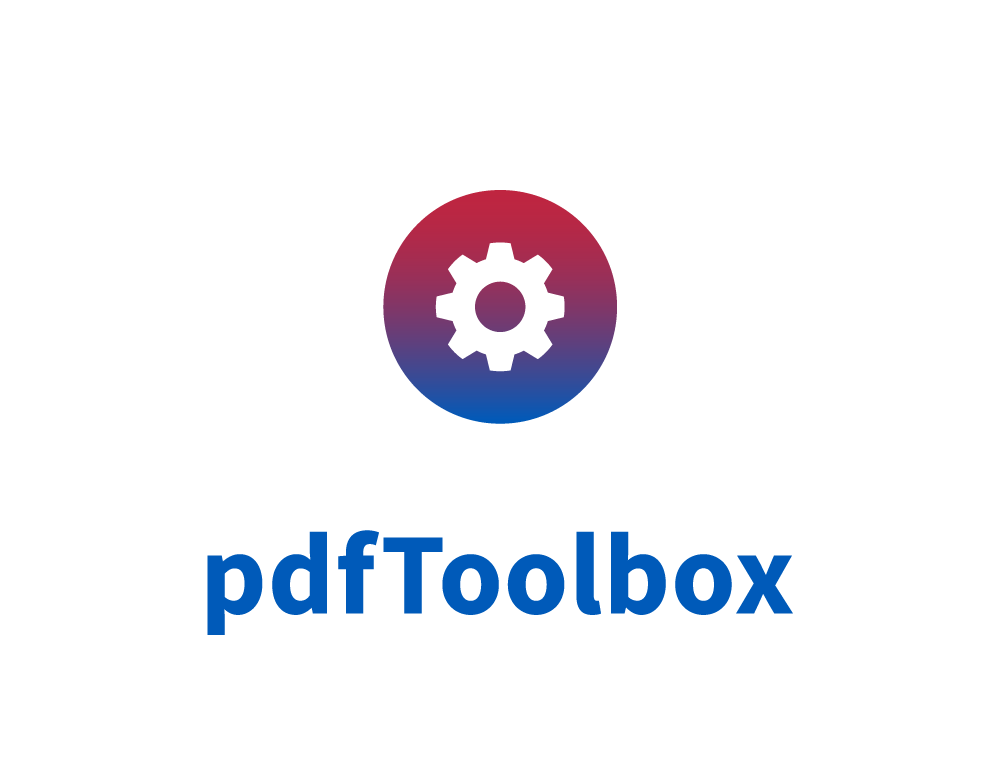
callas pdfToolbox
The all-round, and most powerful, tool in the field to
preflight, validate, optimize, correct and repurpose PDF files for
prepress, print production, packaging production,
digital publishing, and accessible PDF
|
callas pdfToolbox - Who is it for?
- Technicians and print specialists
- Leading print & packaging consultants
- Color management and process control experts
- Press operators & pressroom supervisors
- Quality assurance managers
- Prepress supervisors and technicians
- Brands & brand owners
- Content & media creators
- Anyone who manages color quality
- Ink, paper and packaging suppliers
- Schools and businesses that provide
training in professional skills to:
preflight, validate, optimize, correct and
repurpose PDF files before print/prepress,
print production, packaging production,
digital publishing and accessible PDF
|
|
New key features in callas pdfToolbox

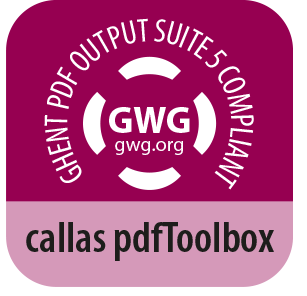
|
callas pdfToolbox Today
callas pdfToolbox has become the most encompassing and
performant PDF technology for printing and related applications.
It has grown from a PDF preflight application to check
the printability of the file to a complete pre-print platform
offering the printing industry everything they need,
ranging from checks & fixups over pdf conversion and
print preparation to rule-based, dynamic process plans
that will modify the files ready to be printed for any
printing process.
callas pdfToolbox technology is a
highly recognized and respected technology.
It is used by small companies, large publishers and
print providers as well as global OEM customers that
integrate the technology in their own products;
among them are:
Adobe Systems Inc., Aleyant, CVISION Technologies,
Dataline, Durst Group, Dynamicsoft,
EFI, Foxit, HP, Kodak, Konica Minolta, Krause,
Mitsubishi, Pixartprinting, Quark Software Inc.,
Rochester Software Associates, Sofha, Xerox.
When ordering callas pdfToolbox from NewFormat AB
you will get the original, very latest version of callas pdfToolbox
directly from the development team at callas softare GmbH.
As production ready tools or for integration into own solutions,
and for a much more favorable price.
|
callas pdfToolbox
- Software tools to convert documents to PDF Standards.
callas pdfToolbox automates and standardizes
the process of file delivery and reception.
callas pdfToolbox provides dynamic preflight,
correction, color management and optimization of PDF files
for prepress, print production, packaging, digital publishing,
advertising, design, and document management.
In automated workflows, callas pdfToolbox has become
indispensable to provide PDF quality control and correction,
conversion of PostScript, image and office formats to PDF,
impositioning, splitting and merging of PDF files and much more.
Out-of-the-box automation with hot folders and easy integration
through the command-line version into any production workflow,
MIS system or web-to-print environment has made
callas pdfToolbox the tool of choice for such environments.
callas pdfToolbox Industry Solutions
Reliable platform for automation and performance all industries.
Solutions for Publishers
Print publishing is a fast-paced and competitive business
with tight deadlines and high customer expectations.
PDFs can come from many different sources
- advertisers, agencies, design departments, etc.
How do one guarantee the highest quality print standards
for publications under such conditions?
With callas pdfToolbox the long chain of production
involved in print publishing need no longer hamper
the reliability of results.
Solutions for Printers
Printers are under pressure to handle more and
more PDF files in ever shorter turnaround periods.
And with PDFs being produced in such a variety of ways,
output mistakes seem almost inevitable.
callas pdfToolbox is used to avoid such output errors,
to save time and money, and to maintain
healthy customer relations.
callas pdfToolbox provides interactive visual inspection and
automatic correction and allows to quickly prepare files
for any intended output.
For transparency and color management issues,
it will correct files so they output as expected through
almost any RIP, meaning you don’t have to make expensive
equipment replacements as PDF technology develops.
|
Preflight with callas pdfToolbox
for trouble-free production
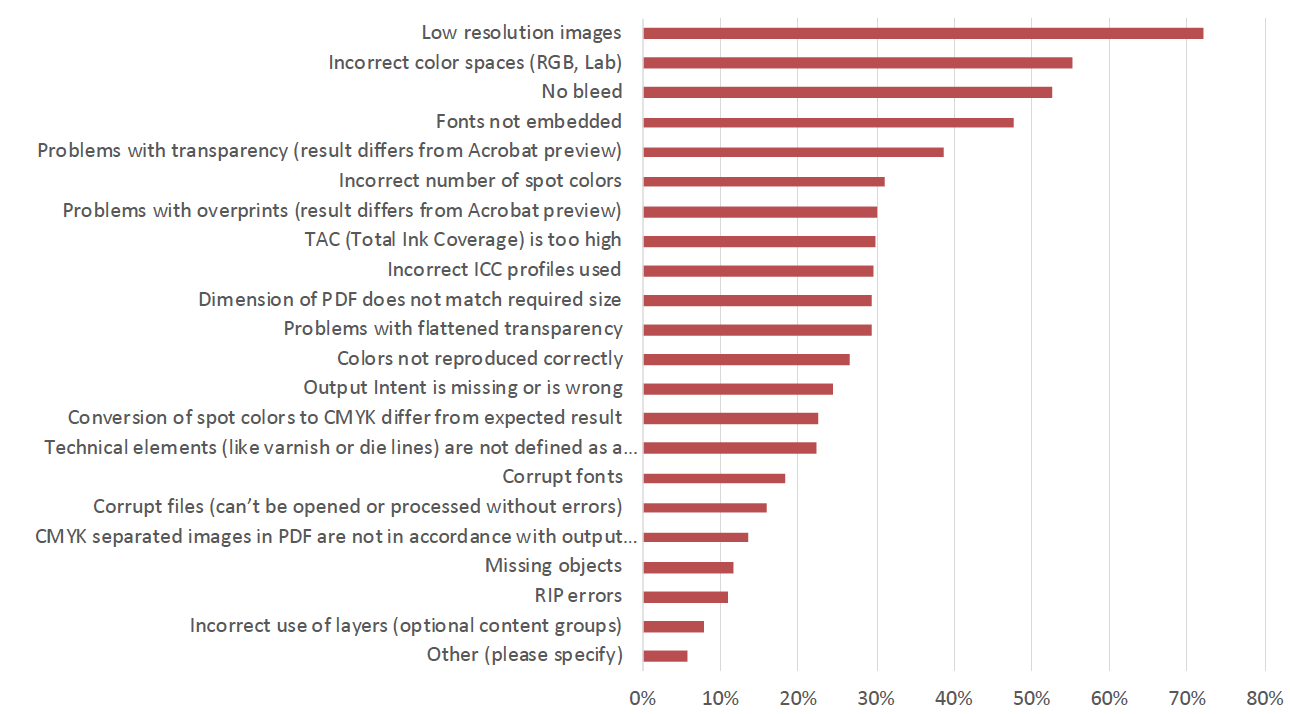
Typical problems in print indata / PDF files
What callas pdfToolbox can do
callas pdfToolbox checks and corrects documents according
to industry standards, including ISO Standards based on
PDF-technology, among them
PDF/X-1, PDF/X-3, PDF/X-4, PDF/X-5, PDF/X-6,
PDF/A-1, PDF/A-2, PDF/A-3, PDF/A-4, PDF/UA-1, PDF/VT,
and others, and market/segment unique specifications from
The Ghent Workgroup.
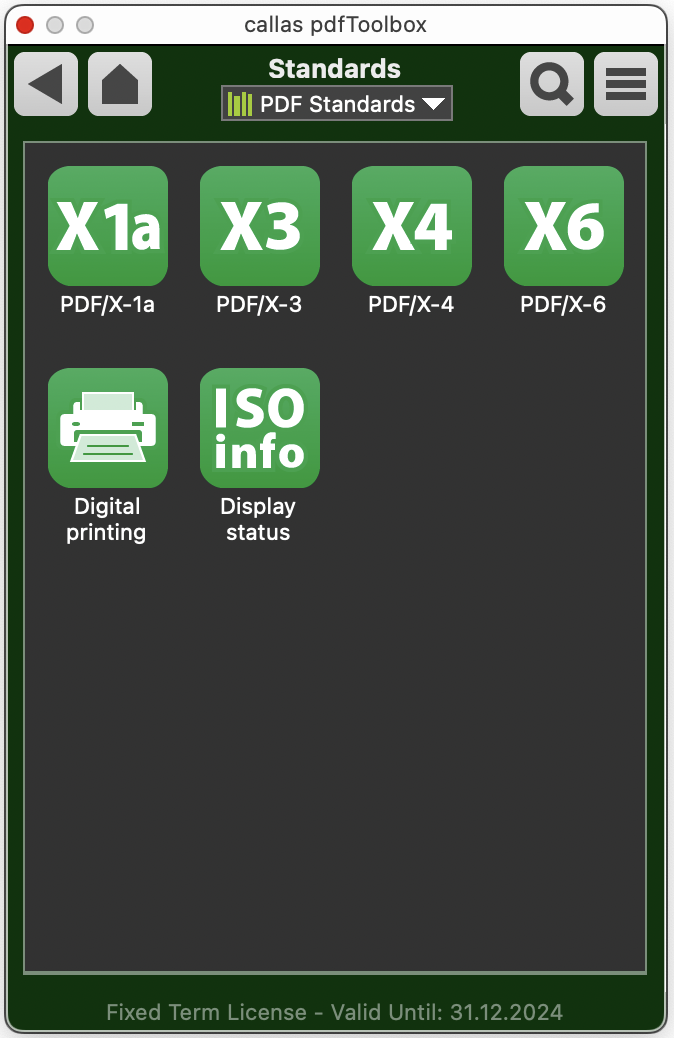
callas pdfToolbox converts native documents created with
Microsoft Word,PowerPoint, Excel, Publisher, Visio and Project,
Apache OpenOffice, Pages (Mac OS X only), PostScript and
EPS, PNG, JPG and TIFF images into print-/publish-ready PDFs.
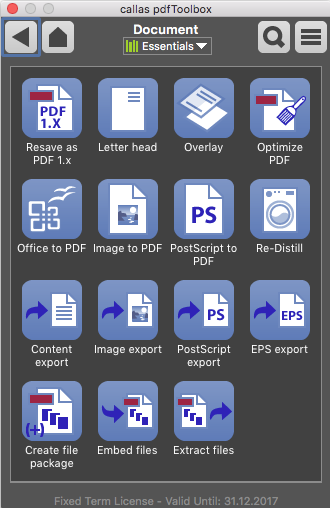
callas pdfToolbox is used for workflow automation,
command-line processing, and dynamic preflighting
to avoid production errors, identify and fix problems,
spot differences in PDF files, imposition tasks
(such as making booklets), step-and-repeat,
split spreads into single pages, and much more...
With callas pdfToolbox one can be confident
that files are ready for even the most stringent of
output requirements through software which is
simplicity itself to setup and use.
All callas software solutions share a common aim whenever PDF files
need to be prepared on a large scale to:
- automate and standardize output processes
- care for quality, safety, speed and efficiency
- provide fully PDF compliant files
- increase productivity
- reduce errors
Guide to callas software solutions,
typical use cases, hands-on exercises and tutorials on:
- checking and correcting PDF Documents / Prelight
- preparing documents for archival
- dynamic workflows dynamic using variables
callas pdfToolbox is compatible with Adobe® Acrobat® DC
(in fact it uses the same rock-solid PDF preflighting technology),
but in addition allows you to automate and batch process PDF files.
callas pdfToolbox
turns print-ready PDFs into
lightweight performant PDF pages for
Mobile Magazines and Periodicals

More and more, magazines are available on
tablets or other mobile platforms.
Consequently, many new apps appear where
subscribers have access to several hundred publications,
such as AppleNews+, Keep In Mind, Readly and many more.
The subscriber uses the respective app to view
the magazine pages, but in many cases
the internal format is actually PDF.
In this blog post, we take a look at what is needed to turn
a print-ready PDF into lightweight performant PDF pages
adapted for mobile publishing.
PDF validation with callas pdfToolbox
Common question: What is a PDF validator exactly validating ?
The rule of thumb is:
A PDF validator (callas pdfToolbox) checks the aspects
that are specifically governed by the PDF standard.
Use of callas pdfToolbox in practice:
Use cases: Preflight, validation, correction and conversion
|
callas pdfToolbox Webinar/Video Recordings, Tutorials, Demonstrations

Quick Speed 5 Minutes Micro-Webinars on callas pdfToolbox - Popup-window
Quick Speed Mini-Webinars on callas pdfToolbox - Popup-window
Webinars/Video Demonstrations of callas pdfToolbox - Popup-window
Best Practices with callas pdfToolbox
Video recordings from the Support Vaults
Season 1 - Popup-window
Season 2 - Popup-window
Hands-on Tutorials with callas pdfToolbox
callas pdfToolbox - Hands-on Tutorials
|
Datasheets/User Manuals
callas pdfToolbox Desktop, Server, Dispatcher, CLI and SDK
|
callas pdfToolbox Training
callas pdfToolbox - Instructor-led Training
callas pdfToolbox Self-Training
This PDF-based self-pace training help users fully
understand and utilize the power of callas pdfToolbox.
The training material is focused on profile creation and
includes exercises with solutions and explanations.
Simply download the following PDF training manual,
open it in a PDF viewer and you are good to go:
callas pdfToolbox@School

callas pdfToolbox for Educational Institutions
All-in-One Solution for Student Classroom Training
|
Price information
callas pdfToolbox software can be obtained via license acquisition or renting.
License is per desktop/laptop and unlimited number of documents, or
per server and unlimited number of users and unlimited number of documents.
For 5pcs or more desktop licenses volume discount apply!
Note! Attractive prices when crossgrading from Enfocus PitStop to callas pdfToolbox.
|
Reference Cases/Customer Use Cases
callas pdfToolbox Desktop, Server, Dispatcher, CLI and SDK
Global OEM CustomersOEMs that integrate callas pdfToolbox technology in their own products;
among them are:
Adobe Systems Inc., Aleyant, CVISION Technologies,
Dataline, Durst Group, Dynamicsoft, EFI, Foxit, HP,
Kodak, Konica Minolta, Krause, Mitsubishi, Pixartprinting,
Quark Software Inc., Rochester Software Associates, Sofha, Xerox, ...
2022: The Riksdag Administration, The Riksdagstryck Unit, Sweden
2021: Durst Group, Durst Workflow
PrePress Digital in collaboration with callas software.
A revolutionary all-in-one- solution, which includes all steps of
the pre-press and production process in one single application.
2019: Beuth Verlag
Beuth Verlag trusts callas software for quality assurance of PDF/A files.
callas pdfToolbox and callas pdfaPilot ensure that the DIN standards
published by Beuth Verlag comply with the ISO standards and are
therefore suitable for long-term archiving.
At the same time, a high degree of automation has significantly
reduced the amount of manual work required.
Beuth Verlag, a subsidiary of DIN, the German Institute for Standardization,
distributes national and international standards and develops specialized
publications for industries, scientific research, trade, the service sector,
academic studies and crafts.
For more details, please see:
or contact NewFormat.
2018: Dynamicsoft integrates callas pdfToolbox in Wsc Printer platform
Dynamicsoft, an Italian software house specialized in e-business solutions for
the graphic arts industry, integrates callas pdfToolbox technology in Wsc Printer,
a print MIS/ERP and web-to-print platform, for automated preflight,
optimization and correction of PDFs submitted by customers.
This new integration of callas pdfToolbox in Wsc Printer allows clients to save
time and resources every day, thanks to the automation of manual tasks.
2018: Quark / QuarkXPress 2018
Quark chooses callas pdfToolbox technology for its new
PDF engine in QuarkXPress 2018 (coming in May 16, 2018).
QuarkXPress 2018 can, thanks to the embedded pdfToolbox technology,
create a single PDF file which at the same time complies with
- PDF/X-4, ISO Standard for Exchange of Printable PDF files,
- PDF/A-2, ISO Standard for Long-term Archiving of PDF files, and
- PDF/UA-1, ISO Standard for Universal Accessibility of PDF files
("Accessible PDF").
2017: Spennare, Nacka, Sweden
2017: Livonia Print, Latvia
2017: Big Image Systems, Täby, Sweden
2015: Forsman & Bodenfors Inhouse AB, Göteborg, Sweden
2015: CS Labels, Willenhall/Wolverhampton, UK
Feeding two Xeikon Cheetah (30 metres per minute presses)
Other supporting technologies:
callas pdfChip, Laidback Solution FileTrain,
ColorLogic ZePrA Colour Management Server,
ColorLogic ReProfiler Digital Colour Engine.
2015: Kodak integrates callas pdfToolbox software technology
into its workflow product KODAK PRINERGY Workflow 7
KODAK PRINERGY Workflow provides intelligent pre-printing
management tools for job and package printing.
The software lets users set up and monitor PDF print data processes and workflows.
The pdfToolbox profiles expand the software’s existing validation and correction
features to allow improved quality control and less manual work for the user.
The software automates associated print production processes, thereby
increasing efficiency and reducing both manual work and financial costs.
The new version of the software further automates all essential
printing functions, with pdfToolbox providing a reliable PDF foundation:
an essential component during quality control and preparation.
2015: QuarkXPress 2015 to use callas pdfToolbox to certify PDF/X-4 files (English, .png)
QuarkXPress 2015, expected to be released at the end of March 2015,
will allow better, faster, cutting-edge PDF output with the help of callas software.
This is because QuarkXPress 2015 will support document output in PDF/X-4 format,
verified by callas software’s pdfToolbox.
This means that PDF/X-4 files exported from QuarkXPress 2015 will be
certified with the same technology used in Adobe Acrobat
2014: Pim Print, The Netherlands
Self-service solution and automation and preflight of prepress checking processes,
complete and integrated automation solution for certifying PDFs;
Builds on callas pdfToolbox Server to validate and correct incoming PDFs,
Datasheet (English, pdf)
2013: National Library of Finland,
Centre for Preservation and Digitisation, Mikkelä, Finland
- 2013: Meganews Magazines, Sweden
Validation and correction of PDF-based periodicals with
callas pdfToolbox Server as part of on-demand printing
2013: Penthion Media Technologies, The Netherlands
Self-service solution for entire publishing process,
complete and integrated automation solution for certifying PDFs;
Builds on callas pdfToolbox Server to validate and correct incoming PDFs,
Datasheet (English, pdf)
2013: Showpad, Belgium
Sales and presentation tool for tablets
running on cloud-based online platform;
Builds on callas pdfToolbox CLI to support PDF,
Datasheet (English, pdf)
2011: SOAR Printing, New Zealand
Web-to-Print Portal based on callas pdfToolbox
for prepress and printing services;
Automated quality control system,
Datasheet (English, pdf)
2009: F.E. Burman, London, England
Web-to-Print Portal based on callas pdfToolbox
for prepress and printing services;
Automated quality control system,
Datasheet (English, pdf)
|
Products
|

callas pdfToolbox
PDF Technology Solutions for
Prepress, Print Production and Publishing
|

Click Here for Free Trial of
callas pdfToolbox Desktop, Server, CLI and SDK
(You will be asked to fill in a trial request form.
To help us identify your software download and support you,
please enter the code NewFormat
in the form field named Preferred Reseller).
|
Overview
|
callas pdfToolbox Swichboard
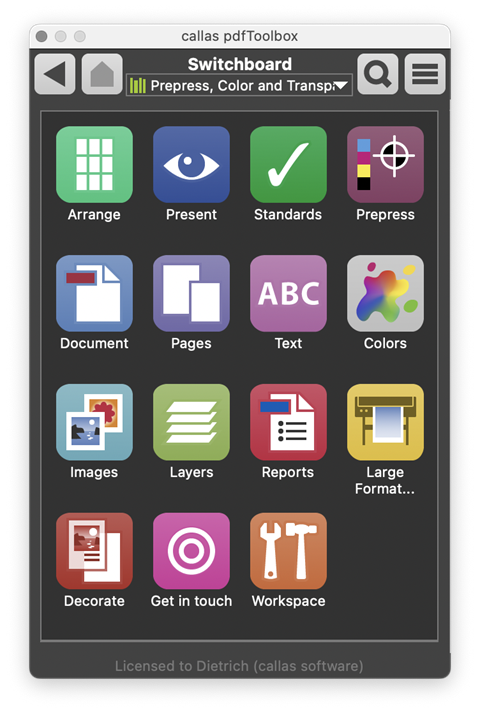
|
callas pdfToolbox Desktop - PDF Production Toolkit
callas pdfToolbox Desktop is the easiest yet most powerful
PDF preflight and correction application on the market.
callas pdfToolbox Desktop installs standalone
or as a plugin inside Adobe® Acrobat®:
- When installed as a standalone application,
pdfToolbox Desktop completely replaces
the inbuilt preflight capability of Adobe Acrobat;
in such cases there is no need to also
buy/install Adobe Acrobat.
- When installed as a plugin into Adobe Acrobat,
pdfToolbox Desktop vastly extends and enhances
the basic, inbuilt preflight capability of Adobe Acrobat.
Easy to use
- Switchboard (user dashboard) for ready-made actions
- Visualizer for visually inspecting PDF documents
Yet powerful
- Profiles for more customization
- Variabels to make profiles dynamic
- Process plans to introduce processing logic
No task is too difficult for callas pdfToolbox Desktop.
Problem files can be fixed during preflight or with a
click of a button in the Switchboard (user dashboard).
Examples:
- flatten transparency,
- convert fonts to outlines,
- insert trim and bleed boxes
to match printer marks,
- convert office documents or even
PostScript files directly into PDF,
- compare versions of PDF files,
- visualize ink coverage,…
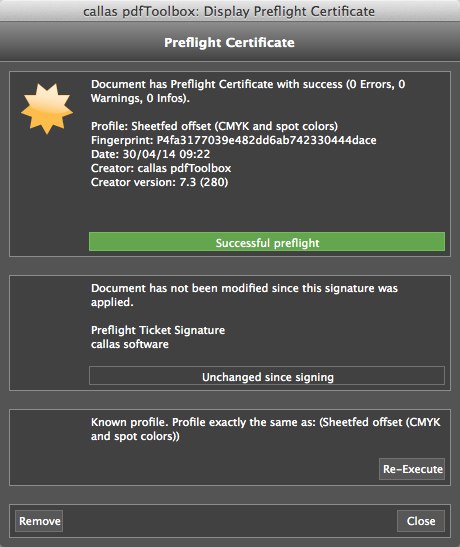
|
callas pdfToolbox
PDF Technology Solutions for Prepress, Publishing, Print Production
callas pdfToolbox comes in several flavours
for specific needs and automation requirements
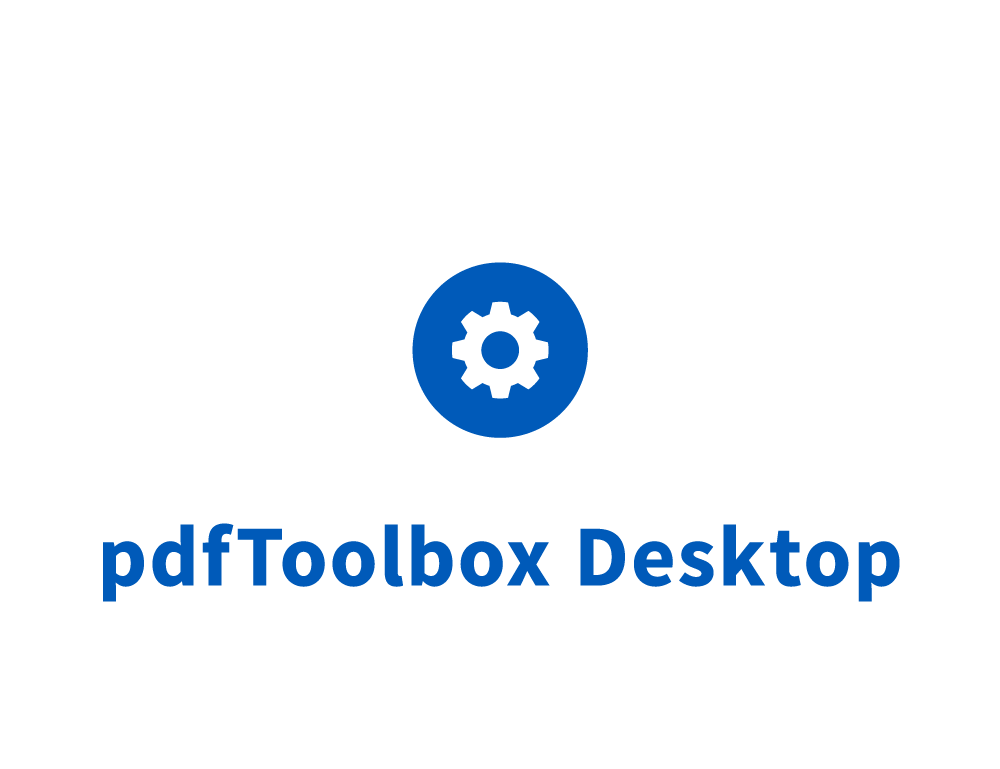 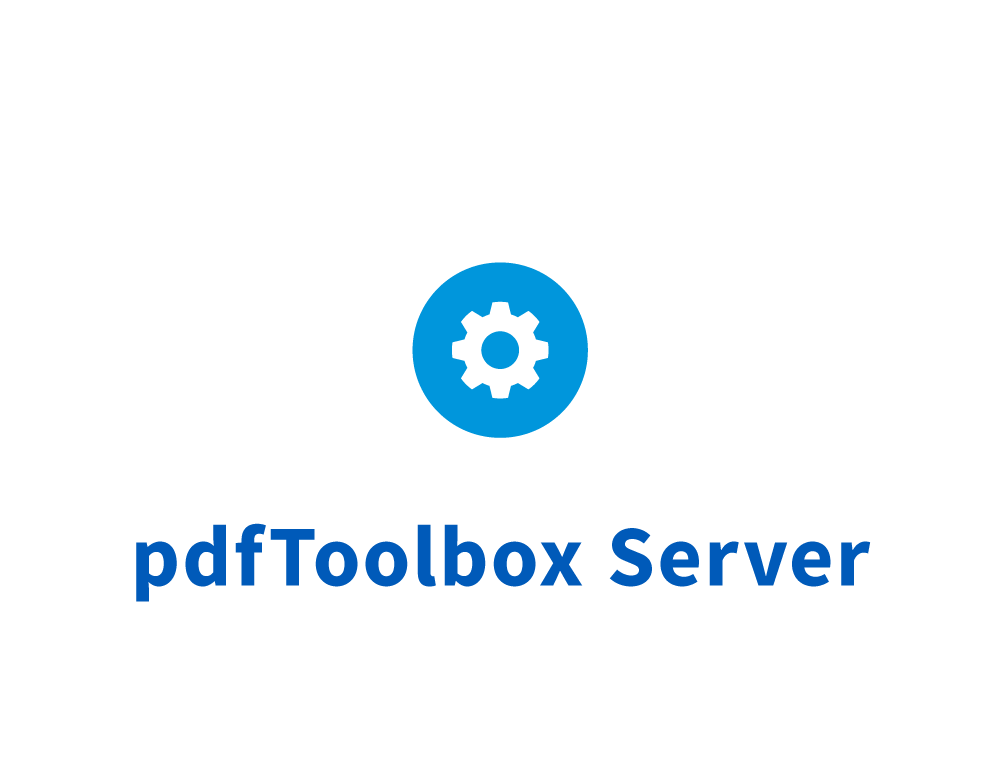 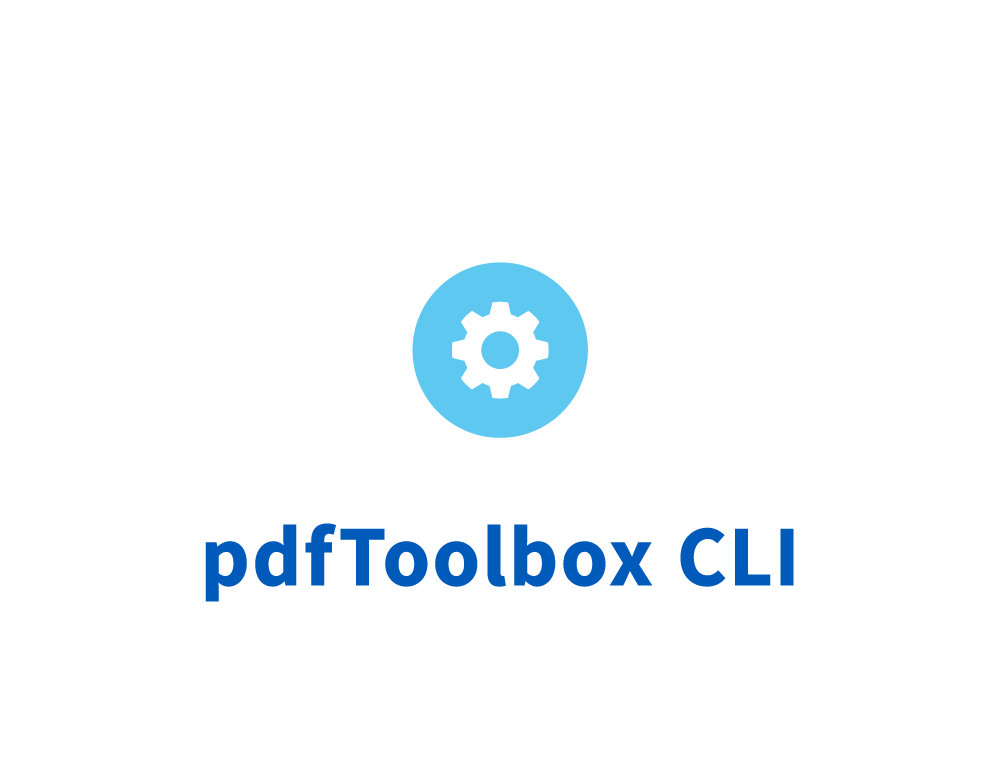 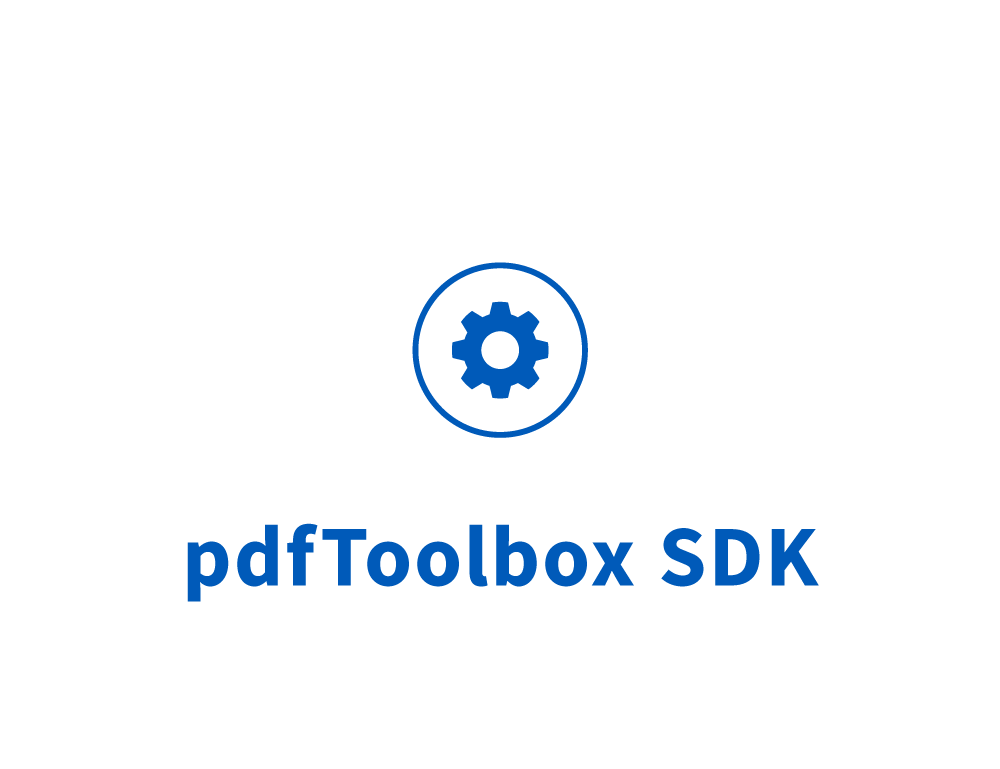
callas pdfToolbox product family, all support the same functionality,
and is is the easiest yet most powerful PDF preflight and correction
application on the market:
callas pdfToolbox DesktopFor individual and interactive use on
desktops (macOS / Windows).
Aimed at providing preflight, correct and repurpose
of PDF files for prepress, print production,
digital publishing and accessible PDF.
Gives all aspects of working with PDFs
a massive boost with a greatly extended
feature set for a diversity of user's needs.
Runs as independent application or
as plug-in for Adobe® Acrobat®.
Fix one file at a time or, in batch mode,
or a whole bunch of PDF documents.
The Switchboard allows you to run any action
on a whole folder of PDF files;
the files are automatically moved to success or
error folders based on the result of processing.
Of course this is not a substitute for
watched folders in pdfToolbox Server and CLI,
but it can save you loads of time
if you need to process multiple documents.
callas pdfToolbox Server & CLIFully customizable server solutions that
allow for automation of workflows through
watched folders or ready for integration into
existing systems through a command line interface.
callas pdfToolbox ServerUsed to automate callas pdfToolbox or
when integrating callas pdfToolbox into an existing workflow.
Hotfolder-based automation for efficient preflight/checking,
correction and perfect color conversion and optimization of PDF files.
Includes one license of callas pdfToolbox Desktop
for configuration and testing purposes.
Integrates into any web-portal or automation workflow.
Direct integration with Enfocus FullSwitch and PowerSwitch
by means of the provided application configurations.
callas pdfToolbox CLI-based
(CLI - command line interface).For automation of PDF processes;
The fastest way for developers to leverage
callas PDF technologies into custom solutions.
Fast, robust integration of PDF preflighting and
processing in any environment.
Fully-featured PDF preflighting, correction,
color-management and imposition functionality
into custom workflows and solutions.
callas pdfToolbox SDKSoftware Development Kit (SDK)
is a programming library/software development kit
for developers with a need for PDF optimization,
validation and correction.
Facilitates the development of any kind of application
that must edit PDF files.
Enables development of state-of-the-art products
to check and correct PDF files.
Includes one license for the callas pdfToolbox Desktop
for configuration and testing purposes.
|
More on "What callas pdfToolbox can do"
"Can Do Things"
- Preflight
- Embedding fonts
- Outlining text
- Comparing PDF files
- Adding a stamp
- Placing (dynamic) barcodes
- Imposition
- Converting RGB
- Flattening transparency
- Converting to image
- Go from/to PostScript
- Changing page size
- Rotating pages
- Removing spot colors
- Fixing spot color names
- Fixing overprinting white (or black)
- Creating rich black
- Comparing PDF versions
- Rearranging pages
- Adding printer marks
- Cropping white space and hidden content
- Use DeviceLink profiles
- Convert to multi-channel PDF
- Convert office files to PDF
- Downsampling images
- Removing layers
- Splitting PDFs
- Viewing excess ink usage
- Adding bleed
- Outlining page boxes
- Adding white margins
- Writing checks with Javascript
- Conditional processing using Javascript
- Adding undercolor white
- Setting page boxes based on page content
- Adding varnish layer
- Adding grommets (eyelets)
- Tiling into smaller pieces
- .
- .
|
Automation
Process Plans
- callas pdfToolbox comes with full support for process plans.
- Process Plans take automation flexibility to the next level:
- They allow defining a number of steps
a PDF file should be processed through.
- Each step can be a preflight profile,
a single preflight check or fix, or an action
(such as creating images, creating a booklet,
exporting as PostScript file…).
- Process plans allow generating preflight reports
based on the result of each step, or can jump
between different steps based on
the processing result of a previous step.
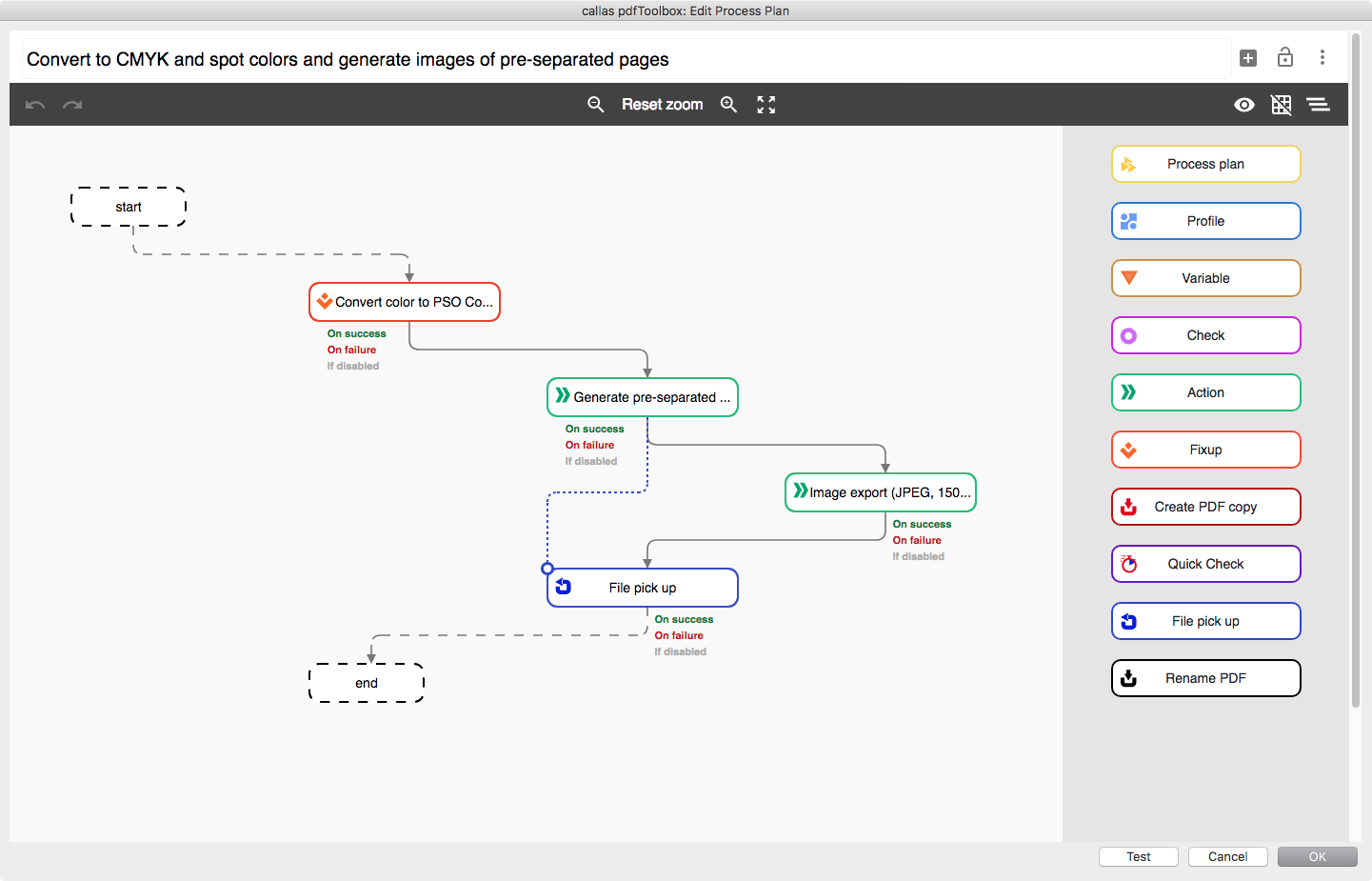
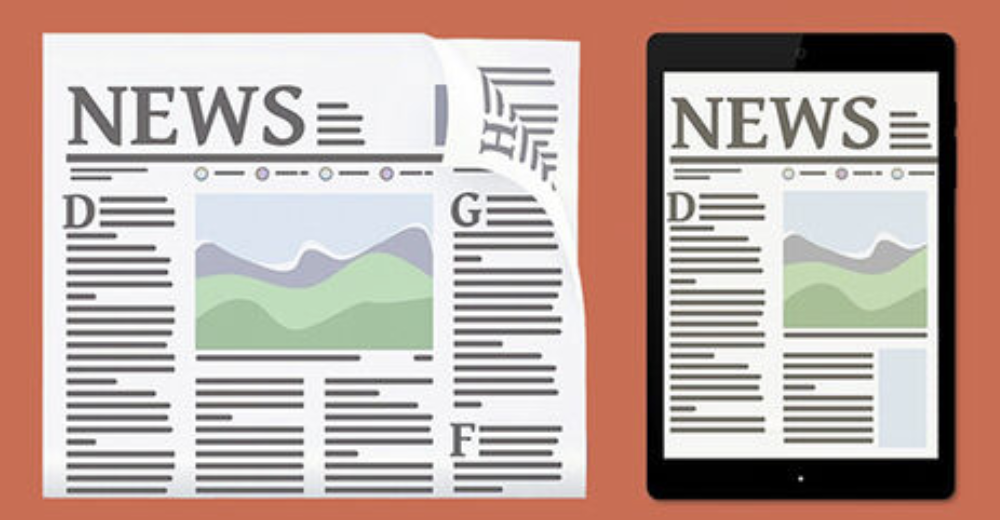
Print paper media vs digital ePapers media
Digitization has revolutionized the way we consume information.
What used to be printed on paper is most of the time
now also available in digital form.
Publishers have fully adapted to the digital age and
extended their reach beyond the traditional print format.
Most newspapers and magazines today offer
digital versions of their publications.
These digital replicas, known as ePapers,
are static representations of the print editions and
usually shared as downloadable PDF files.
This allows readers to easily access the content
on a device of their choice.
QR Codes (Quick Response Codes) are an
important tool that bridges the gap between
printed paper and the digital world:
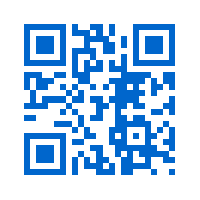
Example:
QR code / web address ( https://www.newformat.se )
which leads to the website for NewFormat AB, Sweden
QR Codes have the capacity to store a wide
range of data and, provide instant access
to the encoded information usually
accessed via a smartphone camera.
Today, QR Codes are omnipresent and newspapers and
magazines are using them to provide readers with
quick and easy access to additional, digital content.
This works very well in a printed publication,
where the QR Codes can simply be scanned
with a mobile device.
However, in a digital ePaper they rather are
a stumbling block in the user experience,
as accessing QR Code content in digital formats
like ePapers is not straight forward.
Maybe you've experienced this before:
You're reading an article on your smartphone and
come across a QR Code that offers extra information
about the topic.
The tricky part is that you can't scan the QR Code
directly with your smartphone camera.
Sure, there are ways to get to the QR Code's content,
but these methods are often not very user-friendly.
In the worst case, you might just give up and
miss out on valuable content.
Ideally, you'd like to have clickable links within the ePaper,
that give you instant access to the QR Code's content
with a simple tap.
But to achieve this, publishers may face a problem:
ePapers are normally derived from the print PDF,
where the destination URLs are already encoded
within the QR Codes.
You would need to extract these URLs for each
individual QR Code to generate link annotations.
Thus, to improve the user experience,
it is important to optimize QR Codes for ePapers.
callas pdfToolbox helps you simplify and automate
PDF creation and allows you to overcome this
QR Code challenge.
This is how you determine QR Code values and
place icons + link for URL:
The solution is a callas pdfToolbox Process Plan
that identifies all QR Codes in a document,
decodes their URLs, and integrates a clickable icon
on top of each QR Code< with the URL that was
encoded in the QR Code behind, providing a
seamless way to access digital content
with just one tap.
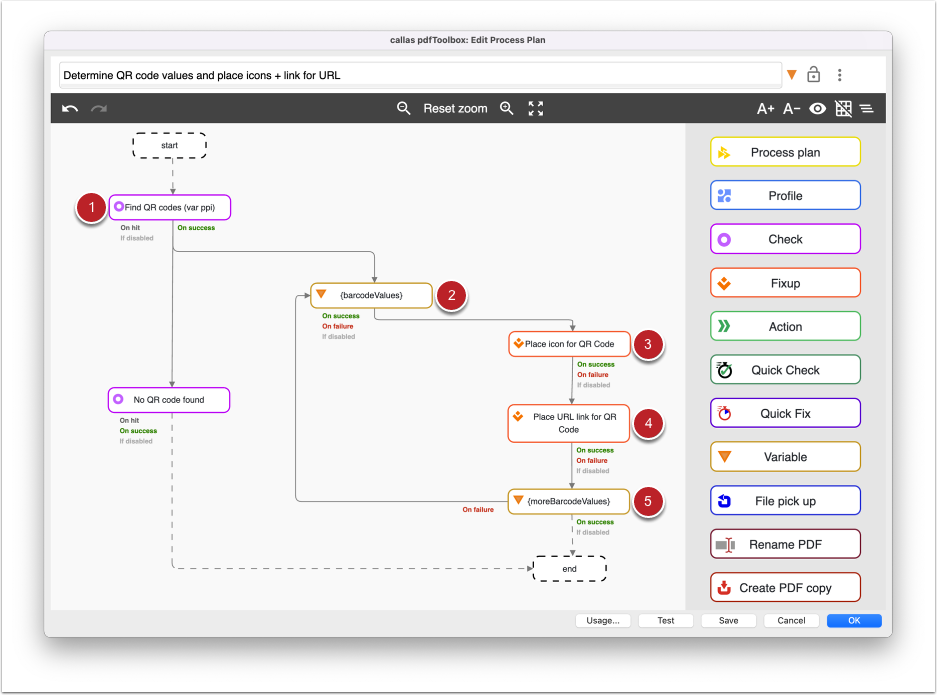
Processplan:
Determine QR Code values and
place icons + link for URL
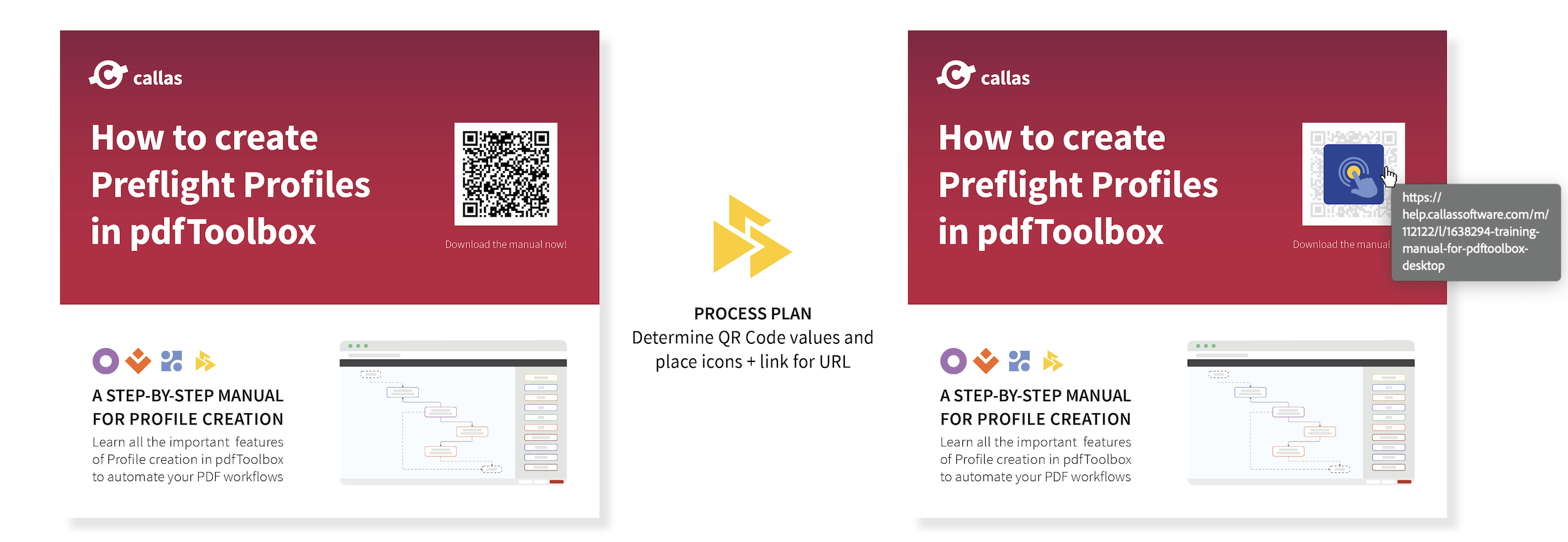
The result after processing according to the Process Plan:
Determination of QR code values and
placement of icons + link for URL

You can download this process plan for free (no cost)
(including a test file and icon) here:
During runtime you can specify which icon
you want to use for the link.
For a detailed article explaining
the different steps of the process plan, please see:
callas pdfToolbox Online Documentation on:
Easy, Automated Impositioning
Impositioning is the action of placement of
the pages on a press sheet so that the sheet
after printing and folding carries the pages in
the correct sequence in the finished printed product.
- callas pdfToolbox scales, fits, moves, extends,
rotates and flips pages and page content easily.
- It also imposes anything from simple booklets
to fully-fledged brochures and books,
as well as doing N-up and step and
repeat impositions for digital printing.
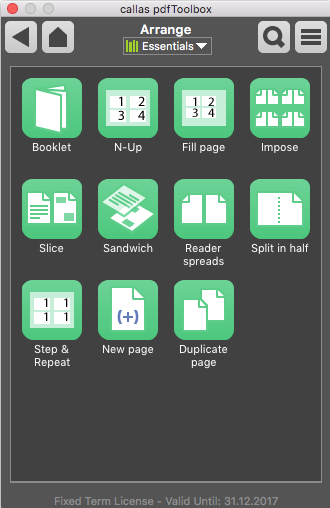
Adobe Compliant Transparency Flattening
- Handling PDF documents with live transparency
when your workflow or output devices don’t
directly support them can be really hard.
- callas pdfToolbox effortlessly flattens
those transparencies while eserving
text, images and line-art as much as
possible and without changing
the intent of the document.
- And you can rely on that result as it uses
well-proven Adobe flattening technology.
Remote Configuration and Monitoring
- Every callas pdfToolbox Server comes with
a copy callas pdfToolbox Desktop.
- callas pdfToolbox Desktop allows connecting
to your pdfToolbox servers;
all configuration and monitoring of
callas pdfToolbox Servers on your network
can be done over the network from the comfort
of your own desktop computer.
Straightforward integration into any
Web2Print or MIS environment
- Of course callas pdfToolbox Server supports hot folders.
- It also allows integration using the command-line (CLI)
or an extensive SDK ideal for embedding the latest
PDF technology straight in your Web2Print or
order administration system.
callas pdfToolbox Multi-Server Productivity via Dispatcher
- callas pdfToolbox doesn't even limit itself to one system.
pdfToolbox can be run on several server systems in cooperation.
- By using automatic load balancing,
callas pdfToolbox allows for configuring a dispatcher
that then distributes work across the network to
satellites running on different systems.
- High performance coupled with easy setup and maintenance.
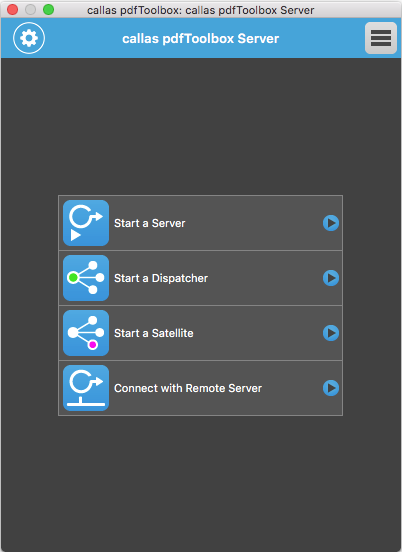
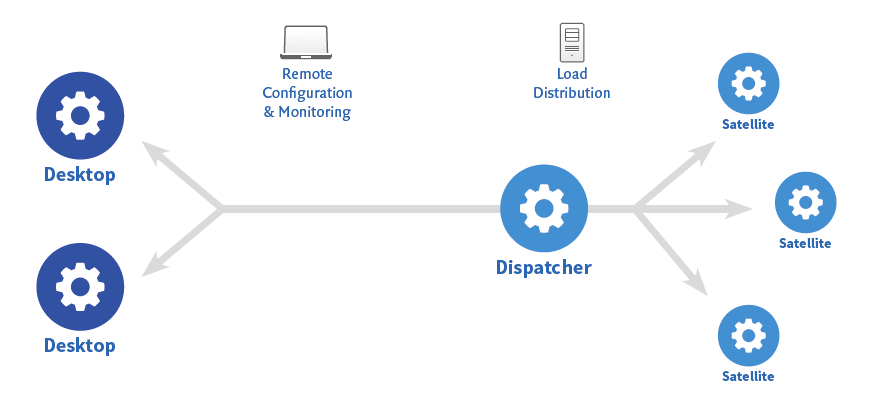
- Allows for load balancing as well as
for fail over configuration.
- Processing of files according to
"dispatcher-satellite" concept.
- Dispatcher
- a server that doesn’t process files itself,
but instead receives files in its job folders and
sends them to satellites to have them processed.
- Satellite
- a satellite is basically a regular server
that will process files.
- As many "satellites" as required can connect to
callas pdfToolbox Dispatcher so that processing
does not stop even if one of the satellites
is switched off.
- Fail over - processing does not stop even if
one of the satellites is switched off.
- For dynamic allocation of cloud-based
processing capacity services,
see callas License Server.
Automation of workflows
- callas pdfToolbox integrates seamlessly with
FileTrain for automation of work flows.
|
PDF Processing Steps Metadata
Standardized PDF metadata for
non-print / post-print workflows
PDF Processing Steps Metadata
callas pdfToolbox support interactive as well as
profile driven evaluation, modification and preflight of
PDF Processing Steps Metadata.
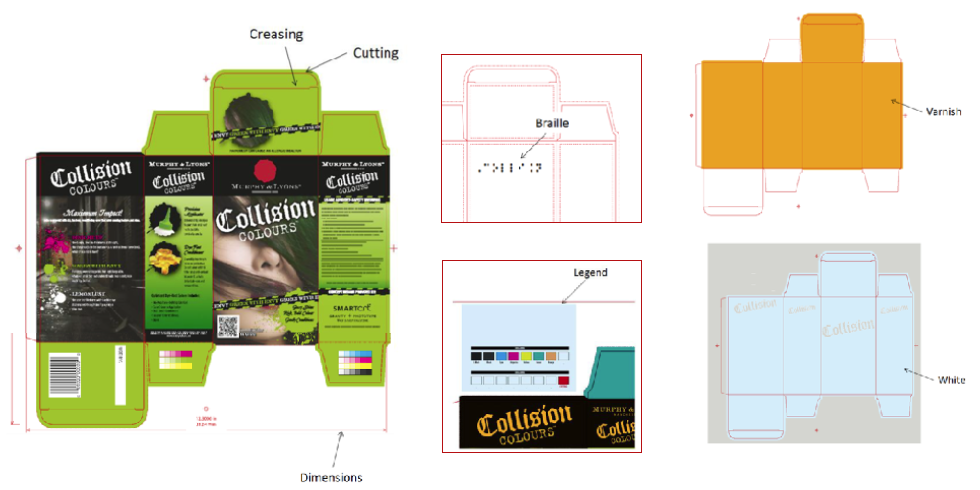
The Processing Steps Concept.
Processing Steps is a specification originally
developed by The Ghent Workgroup to associate
metadata information with non-printing and
finishing processes (such as cutting, embossing,
varnish, conversion, Braille, …) with a PDF document.
PDF files in packaging workflows commonly contain
the design to be printed and elements that are not printed,
yet are crucial to how the printed piece is going to be
further processed.
A prime example is cutting and folding information which
is needed after printing, to cut a box to final format and
fold it into its 3D shape.
The Ghent Workgroup identified years ago
that a lack of standardization in the way these
“processing steps” elements were contained in
PDF documents, were a hindrance to the acceptance of
PDF as the standard format in such packaging workflows.
PDF Processing Steps Use Cases.
Layers can now have both regular metadata and
processing steps metadata attached to them.
The PDF Processing Steps metadata standard is of
is of key importance for packaging-, label- and
large format-specific groups of processing-steps data.
PDF Processing Steps allows packaging and product
developers and designers to specify post-print workflow
components with a PDF file in a language-independent,
vendor-neutral way.
PDF Processing Steps specifies how standardized
post-print workflow elements (e.g. cutting, folding)
can be stored in a PDF file in a standardized way,
a substantial improvement over today’s
vendor-specific arrangements.
The standardisation is based on the ISO Standard 19593-1,
Part 1: Processing steps for packaging and labels,
which defines the use of PDF to associate
processing steps and content data.
With the help of the PDF Processing Steps standard,
standardization of automation of processing steps
in packaging production can be improved substantially.
It standardizes metadata for layers to allow for
interoperability between devices in exchanging
data for non-print processing steps.
In addition, it defines rules for objects in
different layers and dependencies between layers.
It creates the possibility to add standardised terms to
each layer to help identify the layer in subsequent
processing steps in the workflow.
This type of information has usually earlier been
defined as technical spot colors in a PDF.
For lack of standardization, everybody has been using
different names, which made workflow automation
very difficult.
Processing steps metadata is primarily interesting for
packaging since, in addition to the printing objects,
a good deal of additional information are defined in
a PDF for packaging. This allows a language independent
identification of these objects.
This is done by grouping page objects in layers
(technically: optional content groups, OCG),
and adding metadata to those layers to
identify them as processing steps.
With ISO 19593-1, packaging production workflows
can be significantly enhanced to include specifications for
cutting lines, varnishing, embossing, add braille and more
using standardized, language-independent metadata
together with PDF’s Optional Content Groups (OCGs) feature.
When associated with OCGs, processing steps information
allows diverse authors, users or workflow operators to
choose specific elements, for example, to verify cut-marks,
check colors, or other considerations.
Metadata can now be used for selective display of
the elements for validation.
A marketing person is interested in other
elements than a prepress specialist.
For proof output cutting lines, braille, etc. are also printed
while for CTP (Computer To Plate) output they are
automatically omitted.
In addition, subsequent systems
(e.g. impostion, embossing, braille)
which support this standard can retrieve
the information relevant for their
processing step directly in the PDF data.
Use cases include:
- metadata identifying processing steps
- limitations on the interaction between
PDF graphics objects that are part of a
processing step and other PDF graphics objects
- limitations on PDF graphics objects in processing steps
- Easily identifying data corresponding to
"Structural" finishing steps, such as:
- Bleed, cutting, creasing, drilling, embossing,
folding, foil stamping, folding, glueing,
perforating, punching, stapling, varnishing
- Braille in a document
- information panels
- indications of physical dimensions
- indications of intended
positions of graphical elements
- printed white, for example on
transparent or metallic surfaces
- printed varnish
PDF Processing Steps Support in callas pdfToolbox.
PDF Processing Steps Metadata supported in callas pdfToolbox:
- Setting
- Checking
- Adjusting
- Reporting
Setting - In pdfToolbox,
the processing steps metadata is filled out for each layer
using the pdfToolbox Layer Explorer panel.
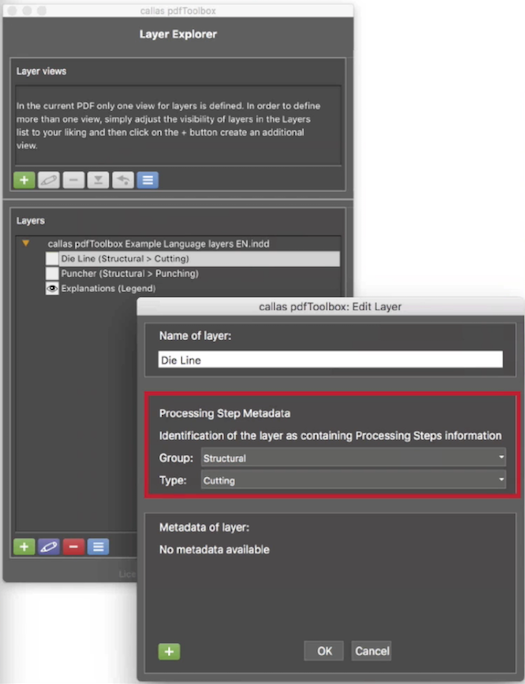
Checking - Properties that can be used in Checks:
- "Processing Steps metadata present"
- "Processing Steps metadata uses custom values"
- "Processing Steps metadata used for more than one layer"
- "Processing Steps"
- Presence of specified Processing Steps,
e.g. “Structural:Cutting”
- Can be combined with any other checks
(e.g. color on Barcode, text or image on Cutting …)
Adjusting - Adjusting Processing Steps:
Configurable Fixups:
- "Add Processing Steps layer metadata” to layer
- “Modify layer name for Processing Steps metadata”
- “Put objects on Processing Steps layer”
- Plus: Relevant layer related Fixups
can use Processing Step metadata
instead of layer names, e.g. “Remove layer":

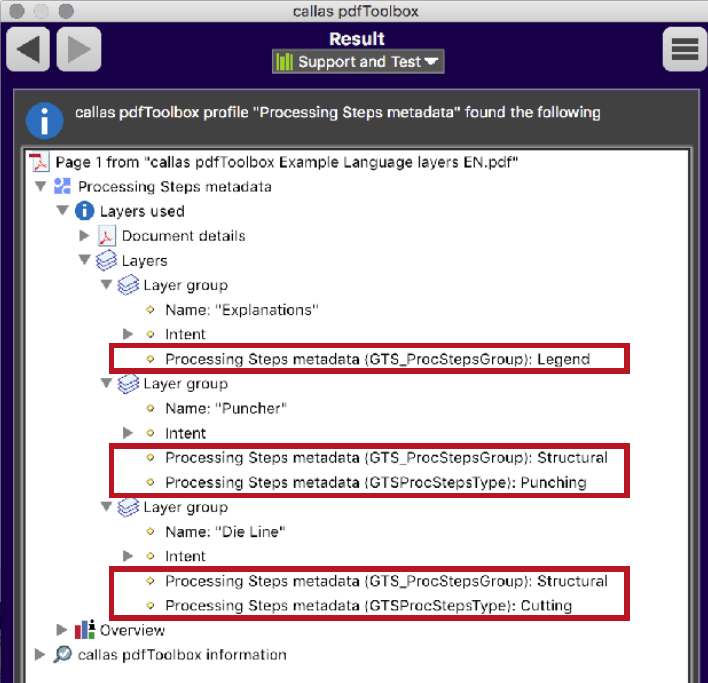
The non-print Processing Steps Metadata option,
and its interactive evaluation,
is also supported through the layer handling in
axaio MadeForLayers and axaio MadeToPrint
for Adobe InDesign and Adobe Illustrator.
|
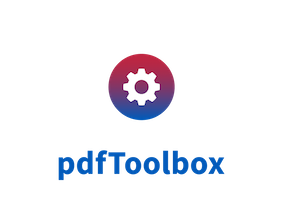

callas pdfToolbox DeviceLink Add-on
for callas pdfToolbox Desktop and callas pdfToolbox Server | CLI | SDK
Enables conversions via supplied DeviceLink profiles
|
callas pdfToolbox Desktop, Server, Dispatcher, CLI and SDK - Details
   
callas pdfToolbox Desktop, Server, Dispatcher, CLI and SDK
Popup-window with details
callas pdfToolbox Desktop vs Server - Feature Comparison Chart
Main features that are supported by
callas pdfToolbox Desktop and pdfToolbox Server.
When purchasing pdfToolbox Server,
a license for pdfToolbox Desktop is always included.
Click on chart for details.
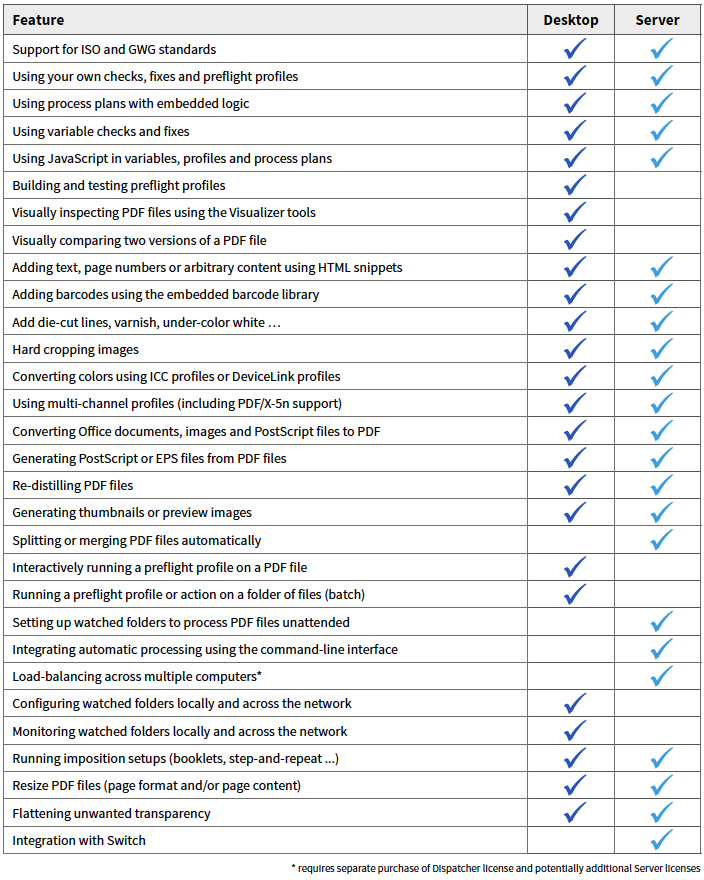
|
For more information contact NewFormat
NewFormat AB
Smörblommegränd 14, SE-165 72 Hässelby (Stockholm), Sweden
tel:+46 (0)70 631 53 01
All content © copyright 2008-2025 NewFormat AB. All rights reserved.
All product names, trademarks and registered trademarks
are property of their respective owners.

callas software Partner
|


































